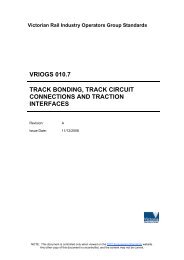St Andrews and Panton Hill: Transport Needs Assessment - Public ...
St Andrews and Panton Hill: Transport Needs Assessment - Public ...
St Andrews and Panton Hill: Transport Needs Assessment - Public ...
You also want an ePaper? Increase the reach of your titles
YUMPU automatically turns print PDFs into web optimized ePapers that Google loves.
2.2 PopulationPopulation levels in the towns of <strong>St</strong> <strong>Andrews</strong> <strong>and</strong> <strong>Panton</strong> <strong>Hill</strong> experienced only minor changesbetween 1996 <strong>and</strong> 2006, presented in Table 1. Comparable figures are not currently availablefrom the 2011 Census from the Department of Planning <strong>and</strong> Community Development howeverbased on these figures <strong>and</strong> the projected populations presented in Table 2, it is expected that thepopulation of the towns in the assessment area will not change significantly in the future.Table 1: Population Changes from 1996 to 2006 (Department of Planning <strong>and</strong> CommunityDevelopment, 2006)Towns 1996 2001 2006<strong>St</strong> <strong>Andrews</strong> 371 394 381<strong>Panton</strong> <strong>Hill</strong> 444 425 518The population of Nillumbik Shire is projected to increase between 2011 <strong>and</strong> 2031 by an annualgrowth rate of 0.6 per cent, presented in Table 2. This is much lower than the rate for theVictorian population, which is projected to increase by an annual growth rate of 1.3 cent over thesame period of time.Table 2: Projected Population from 2016 to 2031 (ABS, 2011, <strong>and</strong> Department of Planning<strong>and</strong> Community Development, 2012)NillumbikShireActual 2011 2016 2021 2026 203160,342 65,939 68,124 70,281 72,238It is expected that most of the growth for Nillumbik Shire will occur in the designated urban areasof Eltham <strong>and</strong> Diamond Creek, not within the assessment area. Eltham <strong>and</strong> Diamond Creek havegreater capacity to accommodate population growth because they are not as hindered byplanning restrictions as the assessment area is.Figure 3 shows the distribution of population across different age groups for the assessment areain comparison to Victoria. The assessment area is populated by a noticeably lower proportion ofpeople over 65 years of age compared to the state distribution. There is also a larger proportionof the population that are school aged in comparison to the state distribution. This suggests thatthe assessment area is home to many young families.Page 6
















